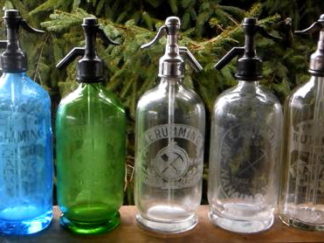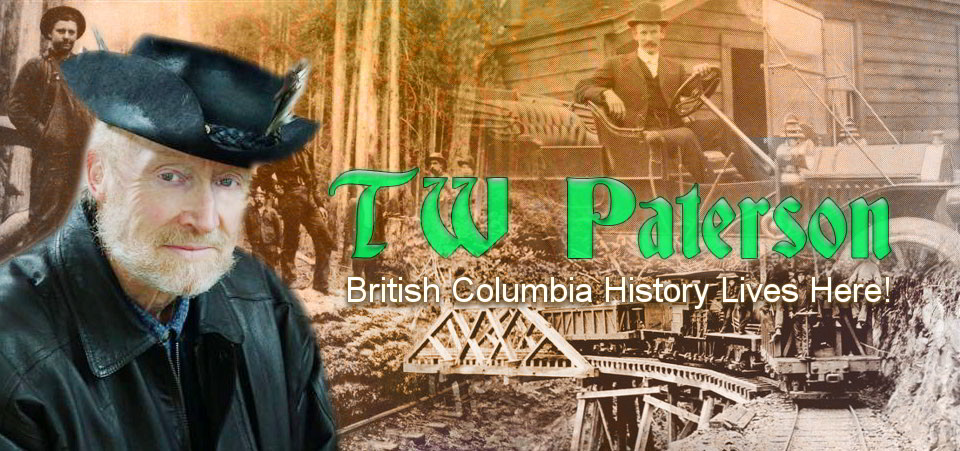RUMMINGS BOTTLES MORE POPULAR THAN EVER
Rummings bottles, with their logo, a crossed pick and shovel, are as ‘Nanaimo’ as the Bastion, but don’t forget the much-sought-after bottles of John Mitchell, Union Brewery, Alex Phillips’ Pioneer Soda Water, and Louis Lawrence.

W.E. Rumming siphon bottles. —www.theouthouse.ca
Nanaimo is highly collectible these days. Old Nanaimo, that is.
We’re talking pioneer bottlers: Besides Rummings bottles, Louis Lawrence, W.E. Rumming, John Mitchell and Union Brewery have become much sought-after since the bottle collecting craze arrived on Vamcouver Island in the 1960s.
Although the hobby has lost some popularity since then, among the die-hards and a new generation of collectors, these old stalwarts have maintained their appeal and have appreciated in value at antique sales, flea markets and online.
It was back in May 1886 that the Nanaimo Free Press mentioned John Mitchell of Bastion Street and his Pioneer Soda Works Manufactory.
He’d just imported “direct from England a new and improved set of machines for the manufacture and bottling of Soda Water”. Today, we’re more inclined to think of soda, which consists of carbonated water with flavouring, as a mixer with our hard drinks; back then it was just pop.
Probably better for the health and teeth, too, than today’s so-called soft drinks with their chemical sweeteners.
The Press predicted that Mitchell’s new machines, fitted with all modern improvements, would place him in the “foremost rank of business, and enable him not only to supply soda water in any quantity, but of a very superior quality. It is to be hoped that this spirit of enterprise will be appreciated.”
For the discerning taste Mitchell offered a fairly wide selection of flavours and products. In their 1970s book Western Canadian Bottle Collecting, George Watson, Robert Skrill and Jim Heidt noted lemon, raspberry, rose, pineapple and orgeat (made from the extract of barley water and sugar flavoured almonds, orange flowers, etc.). Mitchell also offered gum syrups, lemon and gingerade (that’s not a typo), ginger beer, soda water, tonic water, sarsaparilla, nectar and cider.
Business prospered.
Mitchell moved into larger quarters at the corner of Wentworth and Wallace streets and, in 1896, installed a state-of-the-art filling machine from England. Henceforth the company’s bottles bore not only the legend, John Mitchell, Nanaimo, B.C., but ‘Riley’s Patent. The Riley Mnfg. Co., London, S.W.”
Ten years before Mitchell began operations, Victoria businessman Alex Phillips’ Pioneer Soda Water and Syrup Manufactory had established near the Bastion Street bridge. Little is known of this enterprise, unfortunately.
By 1888, Mitchell had competition in the form of Adams & Lawrence’s Eureka Soda Water Works, “wholesale dealers in bottled beer, ale, Porter, soda water, sarsaparilla, cider, ginger ale, syrups, etc.” Louis Lawrence became sole proprietor just two years later when he bought out partners David and Louis Adams, and moved the business to Wallace Street.
But, within a year or so, he’d vanished from the scene and Rummings bottles were on the horizon.
John Mitchell was no longer working alone by this time, having taken Edward Rumming, a professional soda water bottler from the Old Country, as partner. The Mitchell name was replaced with Rumming & Mitchell, then just W.E. Rumming, Nanaimo, B.C., after the latter assumed control of the firm which went under the name of Rummings Bottling Works. The Riley patent mark continued but, best of all, Rumming added a logo.
Rummings bottles have become as ‘Nanaimo’ as the Bastion with their crossed pick and shovel. This company logo has made Rummings bottles among the most popular with collectors although the other brands noted above are scarcer and most valuable.
Over the next half-century and more, Rumming had plants in Nanaimo and Ladysmith and absorbed Courtenay’s Gold Star Bottling Works. As bottles were modernized to take crown caps and to have logos ‘painted on’ rather than embossed in the glass, even the later Rumming bottles lost much of their appeal.
But the old ones, aqua green and dark green, are in their modest ways joys to behold. They often turn up at flea markets and antique sales. Digging them up is quite another story.
The Louis Lawrence bottles are much rarer because of the company’s short career and because most of the bottles were of the so-called ‘marble’ variety. You’d break the seal with a stick (often provided) to drink or pour, with the marble acting as a valve in the bottle’s restricted neck.
That’s what ‘done-’em-in, ‘ most bottles having been broken by boys wanting that precious marble!
See Also: Two lost gold mines and ‘Jolly Jack’ Thornton
Granite Creek’s ‘White Gold’ Still Draws Treasure Hunters
R

I’ve enjoyed reading your writing for more than a decade. I have released a definitive work about the lost gold bars of Camp McKinney and used your material as some of the source, with the appropriate credit given. Your extensive work saved me time in research as I hope mine will for future writers. Chasing Stolen Gold is now available on Amazon and they state it will be made available to stores and libraries in two months. You can read the back cover blurb on my blog. Please keep up your great work. BC and the Pacific northwest is better educated for it.
Fantastic! I shall order it online as I can’t wait for it to hit the book stores. And I’ll check out your blog. Thank you for the notice and your kind words. I’ll get back to you when I read it. Cheers, James.
Comment *in the mid 80s I gave my over 100 collection of BC syphon bottles to the Vancouver Centennial museum. They don’t often have them
On show but if you ask they may invite you to
The collection storage for a visit
Museums are challenged to show all the artifacts in their collections (said to be 7 million in the RBC Museum!) but sometimes create special displays. You have the satisfaction of knowing they’re saved for posterity, Evan.
so I’m new to reselling vintage collectibles and I had a green rumming siphon bottle that I put in my antique booth for $69. Well apparently it was the talk of all the bottle collectors because I guess it’s worth closer to a thousand. *
Monetary value aside, it’s my favourite bottle for its great logo of the crossed pick and shovel.